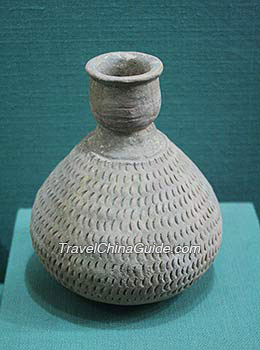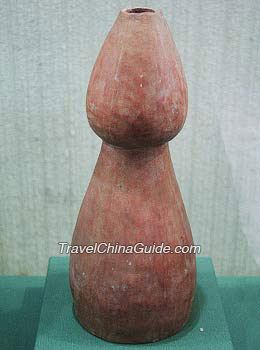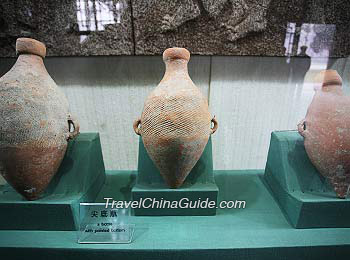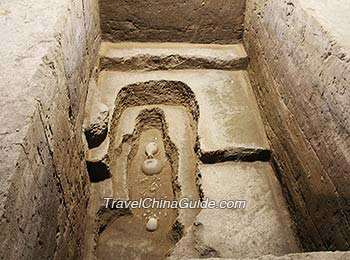Neolithic Age
Starting from about 18,000 years ago, the Neolithic Age marked the end of the Stone Age in Chinese history. During the period, great changes took place in all aspects of humans’ life.
Human beings in the Neolithic Age no longer lived only on collecting foods directly from nature. Instead they began to take up agriculture production and raise livestock: Seeds were used to plant new vegetables; Wild animals were domesticated and their meat cooked for food. The appearance of agriculture and stockbreeding is one of the three features of the Neolithic Age. The other two are that grinding stone implements were started to be made as necessity in the daily life and pottery was invented then.
|
|
Different Developing Phases
In the early phase, many unearthed cultural sites of the past years presented the fact that the grinding stone implements are the representatives of that period, such as the Nanzhuangtou Site in Xushui County of Hebei Province, the Yuchanyan Site in Daoxian County of Hunan Province, the Xinglongwa Site in Chifeng City of Inner Mongolia and other sites. Besides, these sites show that since that period, the original agriculture and stockbreeding had started to develop and the pottery had been the everyday necessity.
During the middle period, taking the Hongshanhou Site in Chifeng City of Inner Mongolia, the Yangshao Site of in Mianchi County of Henan Province and the Dawenkou Site in Taian City of Shandong Province as the representatives, the grinding stone implements had diversified types and much more abundant patterns. Meanwhile, the agriculture and stockbreeding developed well and the pottery craft advanced a lot.
In the late years of the Neolithic Age, the bronze and the stone implements were widely used in the daily life. With the population increasing and society becoming more complex, the human society went into the civilized times. The Wangwan Site in Luoyang of Henan Province, the Majiayao Site in Linzhao of Gansu Province and the Liangzhu Site in Yuhang of Zhejiang Province are the representatives of that period.
Handcraft
In fact, the social development at that time is reflected by the development of pottery craft. In the very beginning, the pottery was simple in craft and patterns without any decoration. Most wares then featured in round and flat bases. Later the pottery was mainly made into red and brown wares with relatively delicate craft. After that, the painted pottery gradually, popular around the area of Yellow River, became the mainstream, among which red pottery and black-grey pottery took a large percent. Another aspect that delineates this age is the appearance of handcraft such as wares made from jade and weaving skills. All kinds of wares were painted to different colors. The handcraft industry was something that greatly enriched people’s lives.
|
|
Clans
Clans, which were different communities made up of people having the same kin and ancestors, were formed. An animal or a plant was usually used as totem for each clan. Members of the same clan enjoyed the same status and belongings, and worked together with the fruits of their labors divided equally under the lead of the head of the clan.
During the early phase, pairing marriage, in which a male or a female could freely choose his or her consort for a short term or a long term, played an important role. Monogamous marriage and polygamous marriage were the basic marriage forms during the middle period. Over the late years of the Neolithic Age, monogamous marriage started to be commonly accepted and was regarded as the standard marital relation. Besides, marriages at that time had to follow some strict stipulations: People of the same clan were not allowed to get married; cousins in the same clan were forbidden to get married etc.
In a word, the Neolithic Age is the headspring of the ancient Chinese culture, and marks economic and cultural advancement in Chinese history, and a new development of human society.
But Chinese "Mesolithic" HAS pottery (simple, but pottery), probably the first in the world, so it has been just more properly named "Early Neolithic". It joins microlithic stone tools with pottery in open air sites of north China, and stone adzels with pottery in the caves of south China.
Sites: 1. Hùtóuliǎng; 2. Xiàchuān; 3. Shìzǐtān; 4. Lóngwángchān; 5. Yùchányán; 6. Zèngpíyán; 7. Xiānréndòng; 8. Dōnghúlín; 9. Zhuànnián; 10. Nánzhuāngtóu; 11. Shàngshān
If you mean "cultural sharing" for artifacts or styles coming from EXTERNAL cultures, I would mention three occasions at least:
Microlithic tools and semi-nomad style of life, similar to siberian-centroasian cultures, before 10000 BCE.
Painted pottery, similar to Mesopotamian one, during Yangshao (ca. 4000 BCE).
Bronze ornaments (not weapons) , similar to the said siberian-centroasian cultures, during Longshan (ca. 3000 BCE).
Horses and chariots, although also imported from the west, correspond more to the Post-neolithic and Bronze ages.
If you mean "cultural sharing" for artifacts or styles passing from a LOCAL chinese culture to other, it has probably been a continuous flow from the beginning to the end of Neolithic, so the answer has to be relative to its importance.
For me the most important one happened just at the very end of chinese Neolithic, when local cultures, shocked or destroyed by the climatic change about 2100-2000 BCE (the same that happened to the Akkadian empire in Mesopotamia and to the Old Kingdom in Egypt, on those same years) moved away from their original lands, and went to join finally (thru all kind of war and peace events) in the plains around Yellow river area. From there came the origins of China (at least the most important: other centers could also exist in Sichuan and south China)



